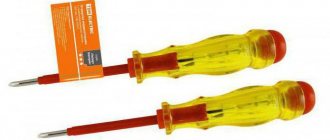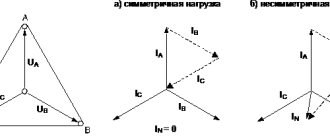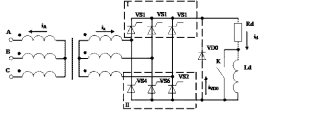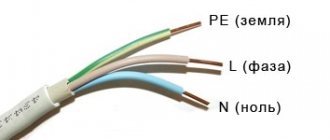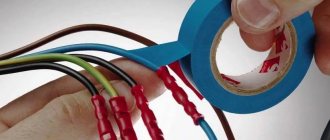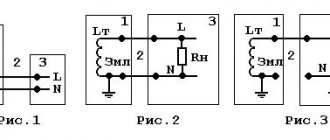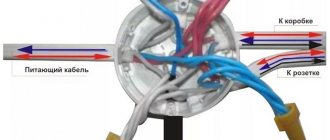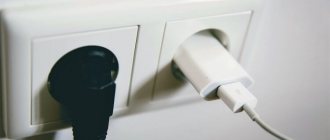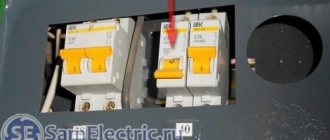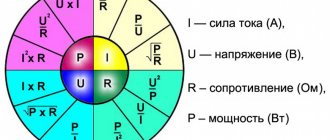Two phases in the socket. Causes. What to do?
April 21, 2016 |
Section: Electrical Hello, dear readers of the site sesaga.ru. Sometimes an interesting fault occurs in electrical wiring that leaves the inexperienced electrician or amateur in a difficult situation. Such a malfunction is the appearance of a second phase in the socket , which ends up in place of zero, which makes you think a lot.
In fact, the same phase is present on both sockets of the socket, since in a single-phase electrical network the 220V alternating voltage is generated by one phase and one neutral conductor, and there cannot be a second phase there. But it is precisely this understanding that causes some bewilderment when a phase is detected in place of the standard zero.
If there really was a second phase in the socket, then the voltage between both phases would be 380V and all switched on household appliances would have to be taken to a repair shop.
Why are there two phases in the socket?
Only one phase enters the apartment through the meter and machines. The socket must have one phase and zero, and in the above situation, the indicator indicates the presence of the same phase in both sockets of the socket.
The most likely cause of the malfunction in this case is damage (break) of the neutral wire going to the socket during the process of drilling the wall.
The presence of a phase where zero should be is due to the fact that it passes through a load - a constantly on light bulb or some other electrical appliance.
As a rule, all neutral wires in a house or apartment are connected to the neutral bus of the electrical panel; a phase will appear in the socket. This is very easy to check - you just need to turn off all electrical appliances in the apartment.
A little theory.
Without going into technical details, we can say that a single-phase electrical network is a method of transmitting electric current when alternating current flows to the consumer (load) through one wire, and returns from the consumer through another wire.
Let's take, for example, a closed
an electrical circuit consisting of an alternating voltage source, two wires and an incandescent lamp.
From the voltage source to the lamp, current flows through one wire and, having passed through the filament of the lamp, making it hot, the current returns to the voltage source through another wire. So, the wire through which current flows to the lamp is called phase
or simply
phase
(
L
), and the wire through which current returns from the lamp is called
zero
or simply
zero
(
N
).
When, for example, a phase wire breaks, the circuit opens, the flow of current stops and the lamp goes out. In this case, the section of the phase wire from the voltage source to the break point will be under current or phase voltage
(phase). The rest of the phase and neutral wires will be de-energized.
If the neutral wire breaks, the flow of current will also stop, but now the phase wire, both terminals of the lamp and part of the neutral wire extending from the lamp base to the break point will be under phase voltage.
You can use an indicator screwdriver to make sure there is a phase on both terminals of the lamp and on the neutral wire coming from the lamp. But if you measure the voltage on the same terminals and wire with a voltmeter, it will not show anything, since in this part of the circuit there is the same phase, which cannot be measured relative to itself.
Conclusion: there is no voltage between the same phase. There is voltage only between the neutral and phase wires
.
Advice
. To determine the presence of phase and voltage in the electrical network, it is necessary to use an indicator screwdriver and a voltmeter together. You can use a multimeter as a voltmeter.
Now let’s move on to practice and consider some situations with zero that you can independently determine and, if possible, eliminate without involving the utility service:
1. Zero break in the entrance panel of a house or apartment
;
2. Zero break at the input or inside the distribution box
;
3. Short circuit of the neutral conductor to the phase conductor in case of mechanical damage to the insulation
.
Zero break in the entrance panel of a house or apartment.
In the input panel of a house or apartment, the neutral wire may break at the input circuit breaker or at the neutral bus. As a rule, the screw connection becomes loose, causing contact between the wire and the clamp to be lost, or, in rare cases, the neutral wire breaks off at the clamp and hangs in the air.
Also, due to poor contact between the clamp and the wire, the wire heats up and burns and, as a result, a large transition resistance in the form of soot forms
, which gradually turns into a cliff.
If there is no zero, all electrical appliances in the house will not work. But if at least one household appliance remains plugged in or the light switch remains on, the phase through the radio components of the power supply
household appliances or
filament
will pass unhindered to the zero bus, and from the bus to all neutral wires of the electrical wiring. And as a result, there will be a phase on both sockets of sockets and contacts of switches. This is because all the neutral wires of the electrical wiring are connected together at the neutral bus.
To determine such a malfunction, it is enough to unplug all household appliances from the sockets and turn off all light switches or unscrew the light bulbs. After these actions, the second phase from the sockets and switch contacts will disappear. The malfunction is treated by restoring the contacts on the terminals of the input circuit breaker or on the zero bus.
Break of zero at the input
If the zero wire in the incoming cable is disconnected, the lights in the apartment will go out and electrical appliances will stop. Checking with an indicator will show the presence of a phase on each contact of the socket. The classic question arises: “Who is to blame and what to do?”
In the absence of zero, the current searches for a free line. If the lamp is turned on, it does not light, but the phase passes through the filament to the neutral wire, then to the bus, and from there to the neutral line of sockets. The phase can also come from a device connected to any plug connector in the apartment. Now there is a phase on each socket of the socket. The indicator emits a light signal when each contact is touched.
A multimeter helps to easily clarify the situation. If you measure the voltage difference between two phases, the device will show a zero value. It is clear that this is the same phase. It is enough to turn off the lamps and disconnect the devices from the sockets and the second phase in the socket will disappear, because the voltage and neutral supply lines do not have other connection points.
It is necessary to restore the incoming zero line. It is possible that the wire has simply become disconnected from the bus. This problem can be dealt with even at home. De-energize the apartment by opening the phase input and check the absence of voltage. Insert the neutral lead into the terminal and tighten the screw.
Zero break at the input or inside the distribution box.
If the neutral wire breaks in front of the distribution box or in the box itself, the problem with the neutral and the operation of electrical equipment will be precisely in the room of the house or apartment into which this box distributes voltage. At the same time, everything in the neighboring rooms will work as normal.
In the figure above you can see that in front of the left distribution box the neutral wire has broken, and the phase through the lamp filament (load) reaches the socket neutral.
When searching for such a fault, the problem box is opened and the common zero twist is found (it is the thickest in the box). The strands are cut off, re-cut and twisted together again.
Advice
. If the wire is copper, then it is advisable to solder the twist.
When the zero breaks in front of the distribution box, as shown in the top figure, to find the break, you often have to open the groove with this wire in the wall to find the location of the damage.
When searching for such a fault, first they find a twist in the box with a common zero and unwind it into separate wires. Then each neutral conductor is called up to the sockets and to the ceiling. The core that will not ring will be the incoming wire into the box.
Next, this wire is pulled through and the plaster in the wall is opened to look for where the wire is damaged. However, such a malfunction is classified as difficult to solve, because few people undertake to pick at the wall - it’s easier to lay a new route.
Short circuit of the neutral conductor to the phase conductor due to mechanical damage to the insulation.
A situation may arise when, when drilling a hole, screwing in a self-tapping screw, or hammering a nail into a wall, the electrical wiring is disrupted. In addition to this, damage to the wiring is accompanied by a short circuit, due to which the wire is damaged completely or partially. Such a malfunction is treated by opening the damage site and restoring the damaged section of the wire.
Sometimes with such a malfunction you can also observe two phases in the outlet. At the moment of closure, the phase and neutral conductors are welded together, and therefore the phase freely flows onto the neutral conductor. Moreover, even when the electrical equipment is turned off from the sockets and the lighting switches are turned off, the phase will be present on those sockets and switches that are supplied with voltage from this wire.
The malfunction is treated by restoring the damaged section of the wiring.
If you still have questions, then in addition to the article, watch the video, which also covers the topic of zero loss.
In this article, we examined only the most common faults that occur in a single-phase electrical network when the neutral wire is damaged. Now if two phases appear in your socket , you can easily identify and eliminate such a malfunction. Good luck!
Source
What happens if you confuse zero with ground?
If the grounding is working properly and is carried out in accordance with all requirements, the error may not be suspected for many years. I have come across incorrectly connected electric stoves many times since Soviet times. However, you should not turn a blind eye to these mistakes:
1. Electricity metering devices will not work correctly, because of this you can get a hefty fine from the power industry when everything becomes clear.
2. When installing differential switches (RCDs) or differential circuit breakers, their correct operation is impossible. These devices will be turned off all the time.
3. Grounding will cease to fulfill its main function - to protect a person from electric shock. In addition, this can become the very cause of lesions.
4. If the grounding in a private house is “weak,” it will quickly fail and, in any case, repairs will have to be made.
Distinguish zero from ground in wiring with three wires
The first step is to set up the device to measure alternating voltage. We insert the probes into the appropriate connectors (in my case these are “VΩCX+” and “com”). Next, we set the mode switch to the AC voltage measurement sector at a value of 750 Volts.
Expert opinion
It-Technology, Electrical power and electronics specialist
Ask questions to the “Specialist for modernization of energy generation systems”
Why are there two phases in the socket? Reasons and solution Most of the malfunction of sockets in one room is associated with incorrect installation of electrical devices, damage to the insulating part. Ask, I'm in touch!
Causes
The problem of two phases appearing in sockets or on switches is not new, and can arise unexpectedly at the most inopportune moment, as in our case in the evening. In this case, electrical appliances do not burn out; they simply stop working.
But it is important to understand that the light can disappear in one or two rooms at the same time, and two phases will appear only in sockets, or vice versa, only in switches (rarely in both cases), thereby stopping the computer, the Internet, etc. But this problem may not affect the kitchen at all.
Why don't electrical appliances burn out? You ask. Yes, because in fact there are not two phases in the outlet, but one. If you take a multimeter, not a probe, and measure the voltage at the terminals of two wires (phase and zero), the device will show “0”. Those. 220V has disappeared somewhere and there is a dilemma - where? And why then does the probe show two phases? The reason for this phenomenon lies in the zero break.
Those. in a normal situation, the electric current flows through the phase wire and returns through zero, while it passes through the switched-on electrical appliances, powering them.
When the zero is broken, to put it simply, the phase does not go to the zero bus of the shield, but remains on the wire and we observe it on the probe. But in reality there is no potential difference between the wires, which is why the multimeter shows “0”.
But we can also observe the following picture: the appearance of two phases in sockets when all electrical consumers are turned off, i.e. the circuit is not closed. And if we adhere to the theory, then the phase current should not return. But for some reason the probe lights up brightly on one wire, but fades on the second.
Here you need to remember about electromagnetic induction. The phase and neutral wires pass very close to each other and due to the electromagnetic field, a slight voltage is generated in the neutral wire, which we see on the probe in the form of a faded glow. If the zero breaks, he also has nowhere to go.
If, for example, you turn on a lamp in the network, then the probe on the neutral wire will burn brightly. At least that's how it was for us.
How to protect yourself?
Having learned about the danger posed by the loss of zero, we suggest considering options for protecting against this phenomenon:
- You need to start with proper installation of electrical wiring. If it is planned to use a three-phase power supply circuit to power the facility, then it must be calculated in such a way as to minimize the likelihood of phase imbalance. That is, it is necessary to systematically distribute the load on each line.
- Devices that balance the load on each phase should be used in network management. Moreover, ideally, this work should be carried out without the involvement of operators, that is, it should be performed automatically when the zero is broken.
- It should be possible to quickly change the consumer connection scheme. This allows adjustments to be made if at the design stage the load on each section was not properly taken into account or the power consumption increased due to the commissioning of new facilities. That is, if a critical situation arises, it must be possible to change the power. An example is when an apartment building is transferred to a line with a higher load to “dilute” the phase imbalance that occurs when the zero is broken.
In the above options, we considered protection against distortions on a global scale; the end user can provide the required level of protection much easier. To do this, it is enough to install a voltage control relay, in which you indicate the permissible minimum and maximum levels. As a rule, this is ±10% of normal.
From theory to practice
If the light went out in one of the rooms, the circuit breaker did not work, i.e. there was no short circuit, you need to take a probe and see what is happening in the sockets or switches, and if two phases are observed there, then you need to look for a zero break.
Reasons for missing zero
Zero can disappear for many reasons, the most common are listed below:
Places where a zero can burn out
A zero can burn out on any segment, starting from the main panel on the site and ending directly with the outlet. But if the problem occurs on the site (common corridor), then, as a rule, the light will go out in the entire apartment.
And if the common main neutral wire that connects all the apartments on the site and goes into the shaft burns out, then a sharp increase in voltage in the apartment is possible, up to 380V, as a result of which all electrical appliances will burn out. That is why, more and more often, automatic switchboards are being installed in common electrical switchboards, which protect the network from overloads.
But if the apartment has a panel with package switches and a zero bus, and two phases in the sockets are observed only in separate rooms, then the problem must be looked for on the line for which a certain package is responsible.
So, zero can disappear:
Zero break in a single-phase network
Here the picture will be as follows:
Zero break in a single-phase network
For a load that operates on other phases, nothing will change at all. It’s the same as if you turn off the automatic circuit breakers in your apartment – your neighbors won’t give a damn.
But if a break occurs, for example, in a panel, then the entire apartment, including the broken end of the neutral wire, will be under 220V voltage!
Breakage (burnout) happens because of rusty bolts like those at the top of this photo:
Bad zero. Missing zero in the apartment
I repeat - if the grounding is done correctly, or if there is no grounding at all, this accident is not dangerous in any way. And, of course, you don’t need to touch the wires without waiting for an electrician - all have deadly potential!
Okay, we understand who is to blame. What to do?
Troubleshooting
Here you need to proceed from the situation where the light has gone out, in the entire apartment or only in certain rooms. We will not consider the first case, since this is a separate story.
In the second, when two phases appeared in the sockets, it is important to understand where the zero break occurred. It is difficult to immediately identify this place, so you need to follow the path of least resistance.
But looking ahead, let’s say right away that in our situation, the zero break occurred in the wall.
To calm your soul, you can, of course, look at the main switchboard on the landing, but since the light in the apartment was only partially lost, you don’t have to look for the cause of the problem there. Unless, of course, there are several neutral wires going there from the apartment, and not one common one.
Next, we move on to the panel with package switches (you may have a different one) in the apartment.
As a rule, each packager is responsible for a separate line going to:
This is all approximate, it may be different for everyone. Accordingly, each line has its own neutral wire.
Those. if two phases in the sockets appear on the same line, then all is not lost; you can take and temporarily use an extension cord by connecting it to an outlet on the working line, for example, in the kitchen or hallway.
Next, we find the packet that is responsible for the line where the voltage disappeared and two phases appeared. This is not difficult to do using a probe.
To be more convincing, we take measurements with a multimeter; a reading of “0” will only confirm our hypothesis.
There is no point in looking for the neutral wire on the bus that is responsible for the problem line; it still goes straight into the wall. You just need to turn off all the packets (for security purposes), check for integrity, and then clean all the neutral wires and the bus itself. If the problem was there, it will be fixed.
If this doesn't help, move on. In our case, the yellow-green neutral copper wire immediately, bypassing the junction box, went to the outlet, but a black copper wire already fit there. Those. somewhere in the wall they are connected and there is a high probability that the zero break occurred exactly there.
In your case, the zero may go to the outlet through the junction box. All this is checked with a probe.
We find this wire in the junction box, check its condition and, if necessary, clean it. Don't forget to turn off the power supply. Next, go to the outlet and do the same.
If preventative cleaning of the contacts did not help, and the wires are in good condition, then the zero is burned somewhere in the wall and this is already a problem.
It’s difficult to find this place; there’s no point in hammering the wall for a few non-working sockets. What is the way out?
In our case, the following solution was found:
Those. in reality, we laid a new zero line instead of the one that was in the wall, and in order not to lead it through the entire apartment to the panel, the nearest working zero bus was found, in our case in the junction box.
Although, if the apartment has old plaster and wires are under it, then you can try your luck, as shown in the video.
Temporary measures
If, for example, a situation arises that the voltage in one of the rooms goes out in the evening and two phases appear in the sockets, then you can temporarily use an extension cord and power, for example, a TV from the corridor.
But this method is not convenient because you can only turn on one or two devices in this way, because they are not located in the same place. Yes, and the extension cord must be 6 or more meters long.
In order to solve this problem in our case, we had to disassemble the old 3-meter extension cord and connect another plug to it instead of sockets. The result is an unusual design; there are two plugs on both sides of the extension cord.
Next, disconnect the wires from the first socket in the line (circuit) coming from the panel with the packets. This is done so that there is no counter tension.
We do not touch the wires that go further into the wall. But it is important to understand which outlet they end on. In our case, this is the sixth one, which is built into the kitchen wall parallel to the socket in the children's room.
We find a working outlet that is connected to another working line, for example, as in our case in the kitchen above the countertop, connect the first plug of the extension cord into it, and connect the second plug to the non-working line through the outermost outlet.
In our case it was close, yours may be different. But we think the meaning is clear.
This way you can easily power one or two rooms. However, in this case, you should not connect electrical appliances that heavily load the network; it is important to remember that for now everything is connected to one outlet.
You can hold out like this for a couple of days until either you or a called electrician sorts out the problem.
Source
Where does zero break occur?
It is fundamentally important that a zero break can occur in three-phase or single-phase networks.
Completely different processes take place there; I’ll go into detail below. In short, what happens:
When the zero is broken in a three-phase network, a phase imbalance appears, which can lead to the voltage in the apartment outlet increasing to 380 V! For a person, if grounding is performed correctly, such an accident is not dangerous. But for our electrical appliances, the consequences can be very sad! And also for our home, since a fire may occur.
The location of the zero break may be a floor panel, then only apartments on one landing are in the risk zone. Or maybe it’s the input switchgear of a multi-storey building. For example, this:
The input switchgear (RU) in the basement of a multi-storey building is in poor condition
If the zero in a single-phase network breaks, the consequences are not so sad - the voltage in the outlet will be zero, and electrical appliances simply will not work. However, the entire electrical network (and if the grounding is incorrect, even the housing of electrical appliances!) will be at a potential of 220 V!
To begin with, to create fear -
The zero in the socket is missing - we explain point by point
One of the popular electrical wiring faults in an apartment is the appearance of the so-called second phase in the outlet. If the light in the rooms goes out, but all the appliances are working, then you too have become a victim of such a breakdown. Next, we will tell you what to do if there are two phases in the outlet, why this can happen and how to fix the damage yourself!
Induced currents
Everything works fine, but the indicator detects voltage on each pin of the plug connector. Moreover: the device shows two phases in the socket when the power supply to the entire apartment is turned off. This completely unrealistic situation can happen if a high-voltage power line runs near your home.
The information posted on this page is for informational purposes only. We recommend that all electrical work be carried out by a professional electrician.
This is the so-called pickup or, to put it more correctly, induced voltage. Even experienced electricians can get confused here. Work in this case is associated with a high risk of electric shock, so only professionals should perform it.
How does this happen?
In order for you to understand the cause of the malfunction, we will provide a visual diagram of the socket-switch-bulb connection:
As you understand, voltage is supplied through the phase wire and returns through the neutral wire. Now imagine what will happen if a zero break occurs:
If you turn on the light switch, the voltage will pass through the filament or a switched-on electrical appliance, go to the neutral wire, etc. the zeros are connected, will go to the socket along the second circuit. The result is that when you check the voltage in the sockets of the socket with a probe, you will see two phases. If you take care of grounding the apartment, there will be no danger to life, you just need to find a break in the neutral wire and restore contact. However, if the electrical wiring was grounded in the apartment, the consequences may not be the best.
A little theory
Without going into technical details, we can say that a single-phase electrical network is a method of transmitting electric current when alternating current flows to the consumer (load) through one wire, and returns from the consumer through another wire.
Let's take, for example, a closed
an electrical circuit consisting of an alternating voltage source, two wires and an incandescent lamp.
From the voltage source to the lamp, current flows through one wire and, having passed through the filament of the lamp, making it hot, the current returns to the voltage source through another wire. So, the wire through which current flows to the lamp is called phase
or simply
phase
(
L
), and the wire through which current returns from the lamp is called
zero
or simply
zero
(
N
).
When, for example, a phase wire breaks, the circuit opens, the flow of current stops and the lamp goes out. In this case, the section of the phase wire from the voltage source to the break point will be under current or phase voltage
(phase). The rest of the phase and neutral wires will be de-energized.
If the neutral wire breaks, the flow of current will also stop, but now the phase wire, both terminals of the lamp and part of the neutral wire extending from the lamp base to the break point will be under phase voltage.
You can use an indicator screwdriver to make sure there is a phase on both terminals of the lamp and on the neutral wire coming from the lamp. But if you measure the voltage on the same terminals and wire with a voltmeter, it will not show anything, since in this part of the circuit there is the same phase, which cannot be measured relative to itself.
Conclusion: there is no voltage between the same phase. There is voltage only between the neutral and phase wires
.
Advice
. To determine the presence of phase and voltage in the electrical network, it is necessary to use an indicator screwdriver and a voltmeter together. You can use a multimeter as a voltmeter.
Now let’s move on to practice and consider some situations with zero that you can independently determine and, if possible, eliminate without involving the utility service:
1. Zero break in the entrance panel of a house or apartment
;
2. Zero break at the input or inside the distribution box
;
3. Short circuit of the neutral conductor to the phase conductor in case of mechanical damage to the insulation
.
Zero is missing from the socket. Is it possible to extend the wire from the neighboring one?
The headache of any electrician is the loss of zero. In its absence, all consumers will be without electricity. The neutral wire appears from the midpoint of the windings of a high-voltage transformer connected in a star. This point is routed to all cabinets and panels, and the grounding bus also extends from this point. The neutral wire is most important for the safety of electrical equipment.
The alternating voltage in the network has a sinusoidal shape. The three phases are shifted relative to each other by an angle of 120*. This is a bit confusing, so these curves are illustrated here. If you measure the voltage with a standard voltmeter, this value between the phase wire and the neutral wire will be 220 V, but this is the average value for half the period. The tester is not an oscilloscope, but only an average meter. In fact, the instantaneous values of peak voltages are greater than 220 V to the square root of 2. In other words, 220 * 2^0.5 = 311 V.
The voltage sine wave says that the average voltage value is 220 V, the peak value is 311 V. Measurements are taken relative to the zero abscissa axis.
The shape of the curve between the two phases is also a sinusoid. The average line voltage is 380 V, and the peak voltage is 536 V.
From the point of view of the average person, it is not clear why when zero is lost, the voltage in the network should increase. Logic dictates exactly the opposite - a complete loss of voltage. And indeed, if you disconnect the neutral wire to your apartment, the light will go out and nothing bad will happen to the equipment. But here we are talking about a zero break at a substation or at floor-to-floor distribution boards.
Let's start unwinding the ball from the very beginning - the active energy meter. At first glance, this is a standard device, but there is a pitfall here. The meter has two windings - voltage, connected between phase and zero, and current, included in the phase break. The voltage between points A and B is 220 V, completely dropping across the voltage winding.
If the zero is broken, the phase will flow through the voltage winding and flow to the consumer. If a consumer takes the indicator and pokes it into a socket, he will detect two phases at once, but the voltmeter will show a stable zero. Perhaps this information will make many people’s brains boil, but there is nothing magical here. It's all about the counter.
If the phase breaks, everything is more logical - nothing will be observed anywhere.
Now about the main thing. When the zero drops to the meters that supply two or more apartments, an interesting process occurs.
What happens in the electrical network when the zero is broken?
Let us consider separately the change in the operating mode of a three-phase network in the event of a break in the main neutral and how single-phase electrical wiring will behave if the neutral conductor burns out at the input.
Zero burnout in a three-phase network
Let's make changes to Figure 1 caused by an accident, namely the disconnection of zero.
The neutral main conductor is broken
In this case, a break in the common neutral wire will cause the flow of electric current through it to stop. As a result, all apartments R1-R3 will be powered using the “star” connection type without a neutral line. In other words, if the zero is broken, each apartment will receive not phase, but linear voltage.
Contour of apartments 1 and 2
As an example, we suggest considering how the situation will develop in apartments 1 and 2. The load of electrical appliances is summed up in this circuit when current I12 passes through it. Accordingly, the voltage level for apartments will be set depending on the load of devices connected to the network. That is: U1 = I12*R1, and U2 = I12*R2. It follows from this that the total current will be I12 = U12 / (R1+R2):
Please note that the total voltage of the circuit will be equal to the linear voltage in this electrical network, that is, U12 = 380 volts. But at the same time, the indicators U1 and U2 can vary in the range of 0-380 volts and, naturally, differ significantly from each other. These values can be influenced by both the load of connected devices in each apartment, as well as its active and passive components.
As a result, if problems occur with the transformer neutral (source zero), there is a high probability of failure of devices connected to the network. The reason is an increase in the voltage level in the network.
Zero break in a single-phase network
In this situation, the consequences will not be as sad as in the case described above, but, nevertheless, if the input zero in the TN-C system burns out, this can pose a serious danger to human life.
Zero burnout in a single-phase consumer circuit
For single-phase loads, a zero break will be similar to a power outage, except for the fact that a potential will remain on the phase wire, which poses a danger to life. Moreover, it will also appear where there was previously a protective zero in the contacts of the sockets. If the housings of electrical appliances were grounded with a working zero, then the likelihood of negative consequences is very high. In TN-CS systems, the risk factor is significantly reduced through the use of a PEN conductor.
How can two phases appear in a regular outlet?
Both meters will remain connected via the neutral wire, but there will be no zero. The situation will be aggravated by the fact that the meters are powered by different phases to ensure uniform loading of the transformer. It turns out that one phase from the first meter will pass through the voltage winding and collide with another phase from the second meter, which also passed through the voltage winding. There will be no short circuit, because... two series-connected voltage windings operating at a voltage of 220 V will be powered from 380 V, i.e. each winding will have 190 V. This is even less than what is stated as acceptable for the windings. For the consumer, it will turn out that on one wire there will be a potential of 220 V, and on the second wire a potential of 190 V. And it seems that everything is also not bad, because at first glance, the voltage in the apartment will be equal to 220 - 190 = 30 V, but this is not so.
Depending on the load, the zero point will shift to a more loaded consumer and instead of 220 V, he will receive significantly less, for example, 100 V less, i.e. 120 V, but his neighbor will receive 380 - 120 = 260 V. If one consumer is is not loaded at all, then it will receive all 380 V into its system. This does not mean that you need to start all the devices to prevent distortion. A zero break is an emergency and is rare.
The literature often describes a phase shift, in which, due to phase asymmetry, the point of zero potential shifts and instead of zero, 5-10 V will hang on the wire relative to the ground wire. In principle, this is normal. It is impossible to connect evenly many single-phase consumers so that the load is perfectly symmetrical. Personally, I measured the current in the grounding wire from the high-voltage transformer to the grounding conductors and it was 4 A. Phase unevenness itself is the norm.
As an experiment, you can take two transformers and connect them in series between two phases. The wire from the midpoint of both transformers must first be connected to the neutral wire. You need to check the voltage on the transformers. The voltage should be 220 V. If you disconnect the neutral wire and measure the voltages on the transformers, then this will be the trick - the voltages will differ if the loads on the transformers are different, or if the powers of the transformers are different, because The resistance of the primary windings will be different.
The results of the experiment are as follows: a zero break causes a phase imbalance between all consumers, shifting the zero point depending on the load of these consumers. The greater the load, the less voltage will come to the apartment.
Useful advice for readers
The situation is clear - the light went out in the apartment and you immediately decided to check the voltage in the sockets with a probe. Having noticed that the indicator shows the phase on two wires, you thought that these were two phase conductors in your electrical wiring. As we have already said, everything is far from the case and you can verify this as follows:
Using a multimeter, check the voltage in the socket; if it shows 0, then you have only one phase, flowing to the neutral conductor.
This is the surest way to determine a malfunction, because an indicator screwdriver is an extremely inaccurate testing method. The indicator may be triggered and show a second phase, although in reality there will be only one.
Finally, we recommend watching another useful video on the topic:
That's all I wanted to tell you about this wiring fault. We draw your attention to the fact that the consequences of this type of breakdown can be very noticeable - if a grounding was used in your apartment, the voltage may transfer to the housing of electrical appliances, which is extremely dangerous. We hope that now you know what to do if there are two phases in the socket, how to fix the damage and why this happens!
Classic socket testing circuit
You can independently determine whether the outlet is faulty by following these steps:
- Take an indicator screwdriver and press the shunt contact with your index finger;
- Check one by one for the presence of phase on the first and then on the second terminal of the socket;
- Check the absence of a phase (ground pin);
- Check with a multimeter that there is no current flowing.
If you can’t draw the right conclusions, you can’t understand what to do if the outlet doesn’t work, contact an electrician or a specialized company for help.
The intervention of a specialist will make the work safe and the sockets will work correctly.
Zero break at the input or inside the distribution box
If the neutral wire breaks in front of the distribution box or in the box itself, the problem with the neutral and the operation of electrical equipment will be precisely in the room of the house or apartment into which this box distributes voltage. At the same time, everything in the neighboring rooms will work as normal.
In the figure above you can see that in front of the left distribution box the neutral wire has broken, and the phase through the lamp filament (load) reaches the socket neutral.
When searching for such a fault, the problem box is opened and the common zero twist is found (it is the thickest in the box). The strands are cut off, re-cut and twisted together again.
Advice
. If the wire is copper, then it is advisable to solder the twist.
When the zero breaks in front of the distribution box, as shown in the top figure, to find the break, you often have to open the groove with this wire in the wall to find the location of the damage.
When searching for such a fault, first they find a twist in the box with a common zero and unwind it into separate wires. Then each neutral conductor is called up to the sockets and to the ceiling. The core that will not ring will be the incoming wire into the box.
Next, this wire is pulled through and the plaster in the wall is opened to look for where the wire is damaged. However, such a malfunction is classified as difficult to solve, because few people undertake to pick at the wall - it’s easier to lay a new route.
